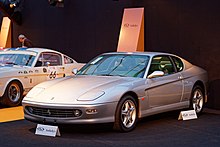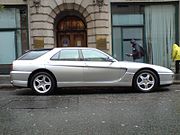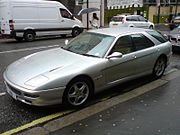Ferrari 456
| Ferrari 456 Ferrari 456M | |
|---|---|
Ferrari 412 | |
| Successor | Ferrari 612 Scaglietti |
The Ferrari 456 and 456M (Type F116) are
456
Pietro Camardella designed the original 456 Grand Tourer at Pininfarina. It was available in GT and (from 1996) GTA models. The former has a six-speed manual, and the latter has a four-speed automatic developed in partnership with
The name 456 is derived from the fact that each cylinder displaces 456 cubic centimeters. This was the last Ferrari to use this naming convention until the 488 GTB. Despite its exceptional performance, the 456 has a relatively unstressed engine, which has proven to be a very reliable unit. A further developed version of this engine was used in the front-engined 550 Maranello grand tourer that was introduced in 1996 and which became the most powerful naturally aspirated Ferrari production car aside from the 456.
The chassis is a tubular steel space-frame construction with a one-piece composite bonnet and body panels of aluminium. The body panels are welded to the chassis by using a special "sandwich filler" called feran that, when laid between, allows steel and aluminium to be welded. Pininfarina was responsible for the bodywork of the 456 until 1996 when production was moved to Ferrari. Total number of bodies made by Pininfarina amounts up to 1,435.[7] All early cars have Pininfarina script and badge, whilst all Modificatas only have the disegno Pininfarina scripts.[citation needed]
456M

The 456M (M standing for Modificata) was unveiled in 1998, starting with chassis number 109589. Many changes were made to improve aerodynamics and cooling and the interior – still featuring Connolly Leather – was refreshed with new seats and other conveniences (fewer gauges on the dash, and a new Becker stereo fitted in front of the shifter rather than behind as in the very shallow and special Sony head unit in the 456 GT). The 456 had a smaller grille with fog lights outside the grille. The undercarriage spoiler on the 456M is fixed, where the older 456 had a motorised spoiler that began its deployment above 105 km/h (65 mph). The bonnet was the first commercial application of carbon fibre, the previous being made of a composite material. Power output remained unchanged on the Modificata using Bosch Motronic M5.2 engine management at 442 PS (325 kW; 436 hp); the cylinder firing order was changed for smoother running and the torque remained the same for later versions of the 456 GT.
456 Bicolore Scaglietti
In the final year of production 2002/3, customers could specify their vehicle using the Carrozzeria Scaglietti Program. Launched at the
Production
The total production of the 456 amounted to 3,289 units. These consisted of the following versions:[8]
456: 1,951
- 456 GT: 1,548
- 456 GTA: 403
456M: 1,338
- 456M GT: 688
- 456M GTA: 650
Performance
According to manufacturer estimates, the 456 GT can attain a top speed of 309 km/h (192 mph)[5] and can accelerate from. 0-100 km/h (62 mph) in 5.2 seconds.[4] The GTA can attain the same acceleration at 5.5 seconds.[9] The Modificata models had the same performance statistics as their respective predecessors.
- Acceleration (seconds) : 0-97 km/h (60 mph): 4.8
- Standing quarter-mile, sec/mph: 13.3/107
- Braking 70-0 mph: 170 ft
- Lateral acceleration: 0.89 g
Road & Track magazine test results for the 1995 456 GT were:[10]
- Acceleration: 0-97 km/h (60 mph): 5.1 seconds
- Standing quarter-mile: 13.4 seconds at 108.8 mph
- Braking 60-0 mph: 124 ft
Road & Track magazine test results for the 1997 456 GTA were:[10]
- Acceleration: 0-97 km/h (60 mph): 5.1 seconds
- Standing quarter-mile: 13.6 seconds 103 mph
- Braking 60-0 mph: 120 ft
- Lateral acceleration: 0.93 g
Motor Trend magazine's test results for the 1997 456 GTA were:[11]
- Acceleration: 0-97 km/h (60 mph): 4.9 seconds
- Standing quarter-mile: 13.3 seconds 105.2 mph
- Braking 60-0 mph: 114 ft
- Lateral acceleration: 0.88 g
- Top Speed, 177 mph
Other body styles
While the 456 2+2 coupé was the only version offered to the general public, five other bodystyles were made on special request of specific customers:
- Ferrari 456 GT Saloon: At least three of these 4-door saloons (sedans) were built by Pininfarina especially for the Sultan of Brunei.[8]
- Ferrari 456 GT Venice: A series of seven 5-door estate (wagon) commissioned by Prince Jefri Bolkiah of Brunei. After Pininfarina designed and built them, the prince purchased six. It is unknown if the seventh car was purchased by a private car collector or if the remaining car was actually used as a development mule for testing. Each car is rumoured to have cost the Sultan's brother around US$1.5 million.[12]The first Ferrari estate ever built.
- Ferrari 456 GT Spyder: A convertible version of the 456, of which two were built by Pininfarina specially for the Sultan of Brunei.
- Ferrari 456 GT Cabriolet: There are also three aftermarket conversions made by the R. Straman Company of Costa Mesa, California, one of which was purchased by boxer Mike Tyson.[13]
- Ferrari 456 Targa: An aftermarket conversion done on a 456GTA once belonging to Shaquille O'Neal. Additional work included removal of the rear seats, to facilitate longer seat rails and a custom sound system.
-
Ferrari 456 GT Venice 4-door estate
-
456 GT Venice (front-left)
-
One of three convertibles built by R. Straman
Awards
The 5.5 L V12 engine used in the 456 won the "over 4-litre" class of the International Engine of the Year award for 2000 and 2001.
References
- ^ "Ferrari 456, production stats". Retrieved 2018-01-03.
- ^ Ben Youssef, Kamel (2006-07-08). "Rencontre avec Pietro Camardella & Gino Finizio" [Meeting with Pietro Camardella & Gino Finizio] (in French). Obdesigner. Archived from the original on 2006-09-26.
- ^ "Designer". ajovalo.net. Retrieved 2012-02-08.
- ^ a b c "Ferrari 456 GT". ferrari.com. Retrieved 10 June 2019.
- ^ a b "Ferrari 456 GT" (PDF).
- ^ a b "Car & Driver, 456 GT Road Test" (PDF). 1993.
- ^ "PRODUZIONE COMPLESSIVA" (PDF). pininfarina.it. Archived from the original (PDF) on 2011-06-05. Retrieved 2007-08-03.
- ^ a b "thesupercars.org". thesupercars.org. 29 September 2008. Retrieved 2012-02-29.
- ^ "Ferrari 456 GTA". ferrari.com. Retrieved 10 June 2019.
- ^ a b "Motor Trend, 456 GTA Road Test" (PDF). June 1997.
- ^ "Motor Trend, 456 GTA Road Test" (PDF). June 1997.
- ^ "Ferrari 456 GT Venice Still Perfect London Grocery Getter". Autoweek. 2017-03-17.
- ^ "1995 Ferrari 456 GT Cabriolet". ferraris-online. 2019-02-20.
External links







